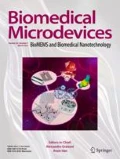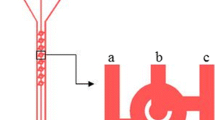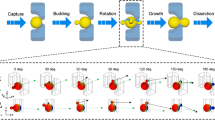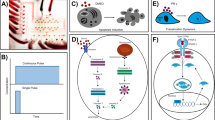Abstract
Cyclo Olefin Polymer (COP) based microbioreactors on a microfluidic chip were produced in house by hot-embossing and thermo-compression bonding methods. The chip allows two different experiments to be performed on trapped cells at the same time. On one side of the chip, red fluorescent protein (RFP) tagged nucleolar Nop56 protein was used to track changes in cell cycle as well as protein synthesis within the yeast cells under the application of the anti-tumor agent hydroxyurea (HU). Simultaneously, on the other side of the chip, the response of yeast cells to the drug metformin, mTOR inhibitor, was investigated to reveal the role of TOR signaling in ribosome biogenesis and cell proliferation. The results of 20 h long experiments are captured by taking brightfield and fluorescent microscopy images of the trapped cells every 9 min. The expression of Nop56 protein of ribosome assembly and synthesis was densely observed during G1 phase of cell cycle, and later towards the end of cell cycle the ribosomal protein expression slowed down. Under HU treatment, the morphology of yeast cells changed, but after cessation of HU, the biomass synthesis rate was sustained as monitored by the cell perimeter. Under metformin treatment, the perimeters of single cells were observed to decrease, implying a decrease in biomass growth; however these cells continued their proliferation during and after the drug application. The relation between ribosome biogenesis and cell cycle was successfully investigated on single cell basis, capturing cell-to-cell variations, which cannot be tracked by regular macroscale bioreactors.









Similar content being viewed by others
References
G.M. Alvino, D. Collingwood, J.M. Murphy, J. Delrow, B.J. Brewer, M.K. Raghuraman, Mol. Cell. Biol. 27, 6396 (2007)
M.C. Bélanger, Y. Marois, J. Biomed. Mater. Res. 58, 467 (2001)
K.A. Bernstain, F. Bleichert, J.M. Bean, F.R. Cross, S.J. Baserga, Mol. Biol. Cell 18, 953 (2007)
H.M. Blank, R. Perez, C. He, N. Maitra, R. Metz, J. Hill, Y. Lin, C.D. Johnson, V.A. Bankaitis, B.K. Kennedy, R. Aramayo, M. Polymenis, EMBO J. 36, 487 (2017)
L.M. Bogomolnaya, R. Pathak, R. Cham, J. Guo, Y.V. Surovtseva, L. Jaeckel, M. Polymenis, Curr. Genet. 45, 350 (2004)
D.J. Burke, D. Church, Mol. Cell. Biol. 11, 3691 (1991)
C. Dez, D. Tollervey, Curr. Opin. Microbiol. 7, 631 (2004)
C. Dubacq, A. Chevalier, R. Courbeyrette, C. Petat, X. Gidrol, C. Mann, Mol. Gen. Genomics. 275, 114 (2006)
C. Dusny, A. Grünberger, Curr. Opin. Biotechnol. 63, 26 (2020)
I. Ebersberger, S. Simm, M.S. Leisegang, P. Schmitzberger, O. Mirus, V. Von Haeseler, M.T. Bohnsack, E. Schleiff, Nucleic Acids Res. 42, 1509 (2014)
D. Falconnet, R.J. Niemistö, M. Taylor, T.G. Ricicova, T. Galitski, I. Schmulevic, C.L. Hansen, Lab Chip 11, 466 (2011)
H.S. Fang, M.F. Lang, J. Sun, Chinese J. Anal. Chem. 47, 1293 (2019)
E. Gencturk, S. Mutlu, K.O. Ulgen, Biomicrofluidics 11 (2017)
Y.D. Gokdel, S. Mutlu, A.D. Yalcinkaya, J. Micromechanics Microengineering 20 (2010)
F. Gomez-Herreros, O. Rodriguez-Galan, M. Morillo-Huesca, D. Maya, M. Arista-Romero, J. de la Cruz, S. Chavez, M.C. Munoz-Centeno, J. Biol. Chem. 288, 31689 (2013)
N. Haandbæk, S.C. Bürgel, F. Rudolf, F. Heer, A. Hierlemann, ACS Sensors 1, 1020 (2016)
M.N. Hall, Transplant. Proc. 40, 5 (2008)
A.S. Hansen, N. Hao, E.K. OShea, Nat. Protoc. 10, 1181 (2015)
M.C. Jo, L. Qin, Small. 12, 5787 (2016)
L.H. Johnston, Curr. Genet. 2, 175 (1980)
Y. Kakihara, T. Makhnevych, L. Zhao, W. Tang, W.A. Houry, Genome Biol. 15, 404 (2014)
J. Kasznicki, A. Sliwinska, J. Drzewoski, Ann. Transl. Med. 2, 57 (2014)
B.A. Kihlman, T. Eriksson, G. Odmark, Here 55, 386 (1966)
A. Koç, L.J. Wheeler, C.K. Mathews, G.F. Merrill, J. Biol. Chem. 279, 223 (2004)
M. La Ferla, A. Mercatanti, G. Rocchi, S. Lodovichi, T. Cervelli, L. Pignata, M.A. Caligo, A. Galli, Mutat. Res. - Fundam. Mol. Mech. Mutagen. 774, 14 (2015)
D.L.J. Lafontaine, D. Tollervey, Mol. Cell. Biol. 20, 2650 (2000)
D.J. Leary, S. Huang, FEBS Lett. 509, 145 (2001)
H. Lempiäinen, D. Shore, Curr. Opin. Cell Biol. 21, 855 (2009)
K. Madaan, D. Kaushik, T. Verma, Expert. Rev. Anticancer. Ther. 12, 19 (2012)
Z.S. Marinkovic, C. Vulin, M. Acman, X. Song, J.M. Di Meglio, A.B. Lindner, P. Hersen, Elife 8, 1 (2019)
C. Mayer, I. Grummt, Oncogene 25, 6384 (2006)
I. E. Odabasi, E. Gencturk, S. Puza, S. Mutlu, and K. O. Ulgen, 1 (2018)
A. Piruska, I. Nikcevic, S.H. Lee, C. Ahn, W.R. Heineman, P.A. Limbach, C.J. Seliskar, Lab Chip.5, 1348 (2005)
M. Polymenis, R. Aramayo, Microb. Cell 2, 94 (2015)
T. Powers, P. Walter, Mol. Biol. Cell 10, 987 (1999)
S. Puza, E. Gencturk, I.E. Odabasi, E. Iseri, S. Mutlu, K.O. Ulgen, Biomed. Microdevices 19, 40 (2017)
F. Scala, E. Brighenti, M. Govoni, E. Imbrogno, F. Fornari, D. Treré, L. Montanaro, M. Derenzini, Oncogene 35, 977 (2016)
G.W. Schmidt, O. Frey, F. Rudolf, Methods Mol. Biol. 1672, 537 (2018)
F. Sherman, Encycl. Mol. Biol. Mol. Medinicine 6, 302 (1997)
D.A. Sinclair, Mech. Ageing Dev. 126, 987 (2005)
M. Thapa, A. Bommakanti, M. Shamsuzzaman, B. Gregory, L. Samsel, J.M. Zengel, L. Lindahl, Mol. Biol. Cell 24, 3620 (2013)
E. Thomson, S. Ferreira-Cerca, E. Hurt, J. Cell Sci. 126, 4815 (2013)
M.W. Toepke, D.J. Beebe, Lab Chip 6, 1484 (2006)
T. Trantidou, Y. Elani, E. Parsons, O. Ces, Microsystems Nanoeng. 3, 16091 (2017)
J.L. Woolford, S.J. Baserga, Genetics 195, 643 (2013)
B.Y. Yu, C. Elbuken, C. Shen, J.P. Huissoon, C.L. Ren, Sci. Rep. 8, 1 (2018)
X. Zhao, C. Luo, H. Wang, Integr. Biol. 11, 79 (2019)
Y. Zheng, Y. Jiang, Mol. Cell. Pharmacol. 7, 15 (2015)
Acknowledgements
This work was supported by Bogazici University Research Fund through projects 13641D and 14261R.
Author information
Authors and Affiliations
Corresponding author
Ethics declarations
Conflict of interest
There are no conflicts to declare.
Additional information
Publisher’s note
Springer Nature remains neutral with regard to jurisdictional claims in published maps and institutional affiliations.
Electronic supplementary material
ESM 1
(DOCX 709 kb)
Rights and permissions
About this article
Cite this article
Gencturk, E., Yurdakul, E., Celik, A.Y. et al. Cell trapping microfluidic chip made of Cyclo olefin polymer enabling two concurrent cell biology experiments with long term durability. Biomed Microdevices 22, 20 (2020). https://doi.org/10.1007/s10544-020-0474-x
Published:
DOI: https://doi.org/10.1007/s10544-020-0474-x




